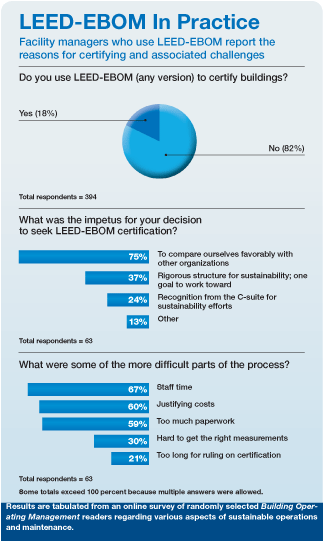FMs Say Formal EBOM Certification Not Expensive, Difficult
A hospital in downtown Cincinnati. A famous office building that is a fixture of the San Francisco skyline. A high-tech lab and classroom building at Western Michigan University.
The commonality between these three seemingly disparate buildings? They've joined a growing list of facilities achieving LEED for Existing Buildings: Operations and Maintenance (LEED-EBOM) certification.
In 2009, more than 275 projects achieved LEED-EBOM certification. Compare that with only 12 certified projects in 2004, 11 in 2005, 17 in 2006, and 27 in 2007.
One reason for the uptick in certifications is that the U.S. Green Building Council (USGBC) has made the submission process easier without compromising the rigor of the rating system, say consultants and facility managers who have worked with different versions of LEED for Existing Buildings (LEED-EB) over the years.
Also, expertise in the industry has increased to the level that facility managers have a variety of resources to turn to — from vendors to consultants — to smooth a LEED-EBOM undertaking. And finally, as new construction has tapered off, more and more facility managers are turning inward and more carefully scrutinizing their existing buildings to find opportunities to add value. LEED-EBOM provides the perfect framework and set of tools for that examination.
"LEED-EBOM is not as scary as everyone says it is," says Al Skodowski, senior vice president and director, LEED and sustainability for Transwestern. "You're doing everything in LEED-EBOM right now. The only question is whether you're doing them to LEED-EBOM standards."
Still, many skeptics ask, "why certify?" When the rating system itself is available as a free download on USGBC's website, why spend the extra money to go through the formal certification process and get nothing more tangible in return than a plaque on the wall?
The answer to that question is best found by looking at certified projects from the perspective of facility managers who strongly believed in certification.

Related Topics:















